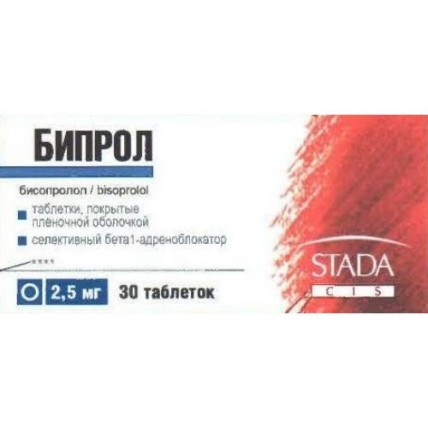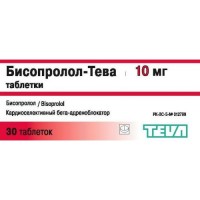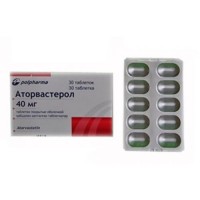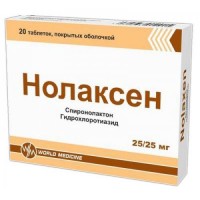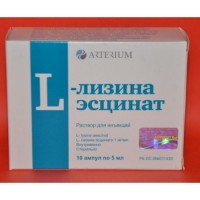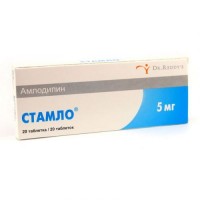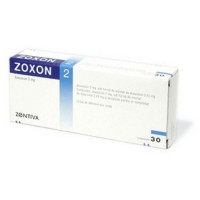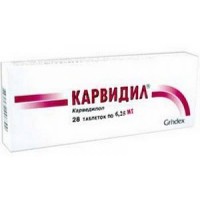Biprol 30s 2.5 mg film-coated tablets
- $4.20
The instruction for medical use of Biprol Torgovoye medicine a name Biprol Mezhdunarodnoye the unlicensed name Bisoprolol Lekarstvennaya the Tablet form, film coated, 2.5 mg Structure One tablet contains active ingredient – the bisoprolola fumarates – 2.5 mg, excipients: microcrystalline cellulose, ludipress LCE (lactoses monohydrate of 94.7% - 98.3%, povidone of 3% - 4%), starch corn, silicon dioxide colloidal (aerosil), krospovidon, magnesium stearate, structure of a cover: titan dioxide (E 171), macrogoal (polyethyleneglycol 4000), gipromelloz (hydroksipropilmetiltsellyuloz), talc. The description of the Tablet of round shape, with a biconvex surface, film coated white color, from risky. On a break the kernel of white or almost white color is visible. Pharmacotherapeutic group Beta blockers. Selection beta blockers. Bisoprolol. The ATX C07AB07 code the Pharmacological Pharmacokinetics Selection Beta1-adrenoblocker properties, without own sympathomimetic activity, does not possess membrane stabilizing action. Has antihypertensive, antiarrhytmic and anti-anginal effect. Blocking heart beta1-adrenoceptors in low doses, reduces stimulated catecholamines formation of cyclic adenosinemonophosphate from adenosine triphosphate, reduces intracellular current of calcium ions, renders negative hrono-, dromo-, batmo- and inotropic action, reduces atrioventricular (AV) conductivity and excitability. Has only insignificant affinity to beta2-adrenoceptors of smooth muscles of bronchial tubes and vessels and also to the beta2-adrenoceptors participating in metabolism regulation. Therefore bisoprolol in general does not influence resistance of airways and metabolic processes in which beta2-adrenoceptors are involved. When exceeding a therapeutic dose has beta2-adrenoceptor blocking effect. The general peripheric vascular resistance which at the beginning of use (in the first 24 hours) increases a little (as a result of reciprocal increase of activity of alpha adrenoceptors and elimination of stimulation of beta2-adrenoceptors) in 1-3 days returns to initial, and at prolonged use decreases. Antihypertensive action is connected with reduction of minute volume of blood, sympathetic stimulation of peripheral vessels, decrease of the activity system renin-angiotensin-aldosteronovoy (is of great importance for patients with initial hypersecretion of renin), recovery of sensitivity of baroreceptors of an aortic arch (there is no strengthening of their activation in response to a lowering of arterial pressure) and influence on the central nervous system. In arterial hypertension the effect develops in 2-5 days, stable action – in 1-2 months. Anti-anginal action is caused by reduction of need of a myocardium for oxygen as a result of an urezheniye of heart rate and decrease in contractility of a myocardium, lengthening of a diastole, improvement of perfusion of a myocardium. Due to increase in end diastolic pressure in a left ventricle and increases in stretching of muscle fibers of ventricles can increase in an initiation of treatment oxygen requirement, especially at patients with the chronic heart failure (CHF). Antiarrhytmic action is caused by elimination of aritmogenny factors (tachycardias, superactivity of sympathetic nervous system, the increased content of cyclic adenosinemonophosphate, arterial hypertension), reduction of speed of spontaneous excitement of sinus and ectopic pacemakers and delay of AV of carrying out (mainly in antegrade and, to a lesser extent, in retrograde the directions) through an atrioventricular node and on additional ways. In chronic heart failure bisoprolol reduces expressiveness of activation sympathoadrenal and system renin-angiotensin-aldosteronovoy that promotes prevention of progressing of a disease, improvement of the forecast and reduction of number of hospitalization. Bisoprolol, unlike non-selective beta blockers, at use in average therapeutic doses has less significant impact on the bodies containing beta2-adrenoceptors (pancreas, skeletal muscles, smooth muscles of peripheral arteries, bronchial tubes and a uterus) and on carbohydrate metabolism, does not cause a delay of ions of sodium in an organism. Pharmacokinetics Absorption. Bisoprolol almost completely (more than 90%) is soaked up from digestive tract. The bioavailability after intake is up to 90% (owing to an insignificant metabolization at primary passing through a liver). Meal does not affect bioavailability. The maximum concentration in blood plasma is reached in 2-3 hours. Distribution. Communication with proteins of blood plasma – about 30% that reduces interaction probability with other medicines contacting proteins. Bisoprolol is distributed rather widely, distribution volume – 3.5 l/kg. Permeability through hematoencephalic and placentary barriers – low. Metabolism. It is metabolized on an oxidizing way without the subsequent conjugation. All metabolites of a vodorastvorima are also removed by kidneys. The main metabolites found in blood plasma and urine pharmacological are inactive. In researches with microsomes of a liver of the person of in vitro it is established what bisoprolol is metabolized generally by means of CYP3A4 isoenzyme (up to 95%) and in insignificant degree ‒ CYP2D6 isoenzyme. Biotransformation of a bisoprolol does not accelerate at patients with hyperfunction of a thyroid gland. Removal. The clearance of a bisoprolol is defined by balance between removal by kidneys (50%) in not changed look and metabolism in a liver (about 50%) to inactive metabolites which then are also removed by kidneys, less than 2% are removed through intestines (with bile). Does not collect in an organism. Elimination half-life – 9-12 hours (that allows to accept bisoprolol 1 time a day). The general clearance of a bisoprolol is 15.6 ± 3.2 l/hour, renal clearance – 9.6 l/hour. Linearity. Dependence of pharmacokinetics of a bisoprolol on a dose linear. The pharmacokinetics of a bisoprolol in special clinical cases Pharmacokinetics of a bisoprolol stable, does not depend on age and sex of the patient. At patients with HSN (the III functional class on classification of NYHA) concentration of a bisoprolol in blood plasma is higher, than at healthy volunteers, and elimination half-life increases till 17 o'clock. Renal failure. In case of a heavy renal failure (clearance of creatinine less than 20 ml/min.) and at patients with an anury the elimination half-life of a bisoprolol can increase twice. Liver failure. In a heavy liver failure the elimination half-life is extended till 13-15 o'clock. There is no information on pharmacokinetics of a bisoprolol at patients with HSN and a simultaneous abnormal liver function or kidneys. Indications - treatment of stable chronic heart failure with reduced systolic function of a left ventricle in addition to APF inhibitors, diuretics, and if necessary, to cardiac glycosides the Route of administration and doses Inside, with a small amount of liquid, 1 time a day in the morning (till a breakfast, in time or after it). Tablets should not be chewed or pounded in powder. Preliminary conditions to start the Biprol drug treatment are stable chronic heart failure without signs of aggravation within six weeks, treatment optimum doses of drugs of standard therapy of HSN, lack of changes in standard therapy of HSN in the previous two weeks. The initiation of treatment the drug Biprol demands obligatory carrying out a special phase of titration (selection of a dose) and regular medical control. The titration phase (selection of a dose) the Recommended initial dose of the drug Biprol makes 1.25 mg (½ tablets on 2.5 mg) once a day. Depending on individual shipping, the dose should be raised gradually to 2.5 mg, 3.75 mg, 5 mg, 7.5 mg and 10 mg once a day. Each subsequent increase in a dose has to be carried out with an interval not less than 2 weeks. If increase in a dose of drug is badly transferred by the patient, the dose decline is possible. The maximum recommended (target) dose of the drug Biprol in chronic heart failure makes 10 mg once a day. During a phase of titration the regular control of heart rate, arterial blood pressure and signs of aggravation of a course of chronic heart failure which can develop from the first day of use of drug is necessary. After reception of an initial dose of 1.25 mg (½ tablets on 2.5 mg) the patient should be observed within 4 hours (control of heart rate, arterial blood pressure, disturbances of conductivity, signs of aggravation of a course of heart failure), if necessary drug is cancelled. Each increase in a dose has to be carried out only on condition of good tolerance of the previous dose and a stable condition of the patient. At doubtful shipping and an excessive lowering of arterial pressure the dose is increased 1 time in 4 weeks, at the same time the target dose can be reached by 24th week. If there is no opportunity to reach a target dose, the patient has to receive the most tolerable dose. During titration or maintenance therapy temporary deterioration in a course of heart failure, arterial hypotension or bradycardia can be observed. In these cases it is recommended to carry out at first correction of doses of drugs of the accompanying therapy (diuretic and/or inhibitor of angiotensin-converting enzyme (APF), at inefficiency of this measure the temporary decrease, slower titration of a dose or drug withdrawal Biprol can be required. Resuming of therapy and/or titration of a dose of the drug Biprol should be considered only after stabilization of a condition of the patient. It is not necessary to allow the sudden termination of administration of drug Biprol (as well as any beta blocker) as development of a syndrome of cancellation which is shown by signs of a decompensation of HSN is possible. Therefore cancellation and a dose decline of the drug Biprol should be carried out gradually, under observation of the doctor, taking into account individual reactions of the patient (see the section Special Instructions). At the admission of reception of the next dose of drug it is not necessary to double the following dose. Treatment duration. The drug Biprol is usually appointed for long-term therapy which duration is defined by the doctor. Special groups of patients Patients with a renal failure or a liver. In a renal failure or a liver of light or moderate severity of dose adjustment it is not required. In heavy renal failures (clearance of creatinine less than 20 ml/min.) and at patients with a serious illness of a liver the titration of a dose is carried out with extra care, the maximum daily dose of the drug Biprol makes 10 mg. Patients of advanced age of Dose adjustment it is not required. Children Due to the insufficiency of data the use of the drug Biprol for children and teenagers up to 18 years is not recommended. Patients with associated diseases there are not enough data on use of a bisoprolol for patients with HSN in combination with diabetes of type 1, heavy renal failures and/or a liver, a restrictive cardiomyopathy, congenital heart diseases or defects of valves of heart with the significant hemodynamic disturbances, a myocardial infarction within the last 3 months Now. Side effects the Frequency of the side effects given below is provided according to classification of World Health Organization: very often – more than 10%, are frequent – more than 1% and less than 10%, infrequently – more than 0.1% and less than 1%, is rare – more than 0.01% and less than 0.1%, is very rare – less than 0.01%, including separate cases. From a cardiovascular system: very often – bradycardia, heart consciousness, it is frequent – the profound lowering of arterial pressure, deterioration in a course of HSN with development of peripheral hypostases (puffiness of anklebones, feet) and asthmas, cryesthesia or numbness in extremities (paresthesia), infrequently – disturbance of AV of conductivity (up to a total cross block and cardiac arrest), arrhythmias, orthostatic hypotension, a stethalgia. From the central and peripheral nervous system: often – dizziness, a headache, an asthenia, increased fatigue, infrequently – a depression, insomnia, is rare – hallucinations, nightmares. Usually these phenomena develop at the beginning of a course of treatment, as a rule, are expressed slightly and pass within 1-2 weeks after an initiation of treatment. From a respiratory system: infrequently – laringo- and a bronchospasm at patients with bronchial asthma or obstructive respiratory diseases in the anamnesis, it is rare – allergic rhinitis, congestion of a nose. From digestive system: often – nausea, vomiting, diarrhea, an abdominal pain, a constipation, feeling of dryness of a mucous membrane of an oral cavity, it is rare – hepatitis. From the musculoskeletal system: infrequently – muscle weakness, spasms in gastrocnemius muscles, an arthralgia. From sense bodys: seldom – a disorder of vision, reduction of a slezootdeleniye (it is necessary to consider when carrying contact lenses), a hearing disorder, change of taste, is very rare – feeling of dryness and morbidity of eyes, conjunctivitis. From integuments: seldom – the increased sweating, psoriazopodobny skin reactions, is very rare – an alopecia, aggravation of a course of psoriasis. From an endocrine system: seldom – a hypoglycemia. From a reproductive system: seldom – disturbance of potency (frequency does not differ from placebo). From the immune system: seldom – emergence of antinuclear antibodies with unusual clinical symptomatology of a volchanochnopodobny syndrome which disappear after the end of treatment. Allergic reactions: seldom ‒ skin itching, rash, small tortoiseshell, dermahemia. Laboratory indicators: seldom – increase in concentration in blood plasma of triglycerides, increase in activity of hepatic transaminases (aspartate aminotransferase, alaninaminotranspherase), bilirubin, is very rare – thrombocytopenia, an agranulocytosis, a leukopenia. Other: very seldom – a syndrome of cancellation. Contraindications - hypersensitivity to a bisoprolol, other beta blockers or any of drug excipients (see. the section Structure) - an acute heart failure or chronic heart failure in the decompensation stages demanding intravenous administration of medicines with positive inotropic action - cardiogenic shock - atrioventricular block of II or III degree (without electrocardiostimulator) - a sick sinus syndrome - sinuatrial blockade - symptomatic bradycardia - symptomatic hypotension - severe forms of bronchial asthma or chronic obstructive pulmonary disease - severe forms of an occlusal disease of peripheral arteries or severe forms of a syndrome of Reynaud - not treated pheochromocytoma - a metabolic acidosis - deficiency of lactase, a lactose intolerance, a sprue (monohydrate) - age up to 18 years (in connection with insufficiency of data on efficiency and safety of use) - women in the period of a lactation With care - heavy renal failures (clearance of creatinine less than 20 ml/min.), heavy abnormal liver functions, a restrictive cardiomyopathy, congenital heart disease, valvular heart disease with the significant hemodynamic disturbances, a myocardial infarction in the anamnesis within the last 3 months, AV blockade of the I degree, Printsmetal's stenocardia, disturbances of peripheric circulation, diabetes of the 1st type or diabetes with considerable fluctuations of concentration of glucose in blood, bronchial asthma, a chronic obstructive pulmonary disease, a myasthenia, a thyrotoxicosis, a pheochromocytoma (is a part of drug lactoses at simultaneous use of alpha adrenoblockers), a depression (including in the anamnesis), psoriasis, the burdened allergological anamnesis, the period of performing the desensibilizing therapy, a rigid diet, pregnancy. Medicinal interactions can affect efficiency and shipping of a bisoprolol other at the same time accepted medicines. Such interaction is possible also in case two medicines are accepted through a short period. It is necessary to inform the doctor on other accepted medicines, even in case of their reception without instruction (drugs nonprescription otp
ska). The Antiarrhytmic means of the I class which are not recommended to a combination (for example, quinidine, Disopyramidum, lidocaine, Phenytoinum, flekainid, propafenon): the effect for the period of atrioventricular conductivity can amplify and increase negative inotropic effect. Antagonists of calcium of verapamilovy type and, to a lesser extent, diltiazemovy type render negative effect on contractility and atriventrikulyarny conductivity. Intravenous administration of verapamil to the patients accepting beta-blockers can lead to the profound hypotension and atrioventricular block. Antihypertensive drugs of the central action (for example, clonidine, Methyldopum, moksonidin, rilmenidin): simultaneous use with antihypertensive drugs of the central action can excessively reduce the central sympathetic tone and can lead, thus, to decrease in heart rate and warm emission and also to a vazodilatation. Sharp cancellation, especially before cancellation of beta-blockers, can increase risk of returnable hypertensia. The combinations applied with care Antagonists of calcium of dihydropyridinic type (for example, felodipin and amlodipin): simultaneous use can increase risk of hypotension and also it is impossible to exclude increase in risk of further deterioration in pump function of ventricles at patients with heart failure. Antiarrhytmic drugs III of a class (for example, Amiodaronum): the effect for the period of atrioventricular conductivity can amplify. Parasympathomimetics: simultaneous use can increase time of atrioventricular conductivity and risk of bradycardia. Local beta-blockers (for example, eye drops for treatment of glaucoma) can enhance system effect of a bisoprolol. Insulin and oral antidiabetic means: strengthening of hypoglycemic action. Blockade of beta adrenoceptors can mask hypoglycemia symptoms. Anesthetics: easing of reflektory tachycardia and increase in risk of hypotension (see the section Special Instructions). Digitalis glycosides: increase in time of atrioventricular conductivity, decrease in heart rate. Non-steroidal anti-inflammatory drugs (NPVS) can reduce hypotensive effect of a bisoprolol. Beta sympathomimetics (for example, izoprenalin, Dobutaminum): the combination with bisoprololy can reduce effects of both means. The sympathomimetics activating both beta and alpha adrenoceptors (for example, Norepinephrinum, epinephrine): in a combination with bisoprololy vasopressor effects of these means can be shown, leading to increase in arterial blood pressure and aggravation of the alternating lameness. Such interaction belongs to non-selective beta-blockers more. Simultaneous use with antihypertensive drugs and also with the drugs having ability to reduce arterial blood pressure (for example, tricyclic antidepressants, barbiturates, fenotiazina) can increase risk of hypotension. Combinations which have to be proved Meflokhin: the risk of bradycardia increases. Monoaminooxidase inhibitors (except MAO-B inhibitors): the hypotensive effect of beta-blockers and also risk of hypertensive crisis amplifies. Rifampicin: insignificant decrease in a half-life period of a bisoprolol, is possible in connection with induction of the liver enzymes metabolizing medicine. Usually correction of a dosage is not required. Ergotamine derivatives: aggravation of disturbances of peripheral circulation. Special instructions At the initial stages of the Biprol drug treatment patients need observation with control of heart rate, arterial blood pressure (in an initiation of treatment daily, then 1 time in 3-4 months), electrocardiograms, concentration of glucose in blood plasma at patients with diabetes (1 time in 4-5 months). At patients of advanced age it is recommended to control function of kidneys of 1 times in 4-5 months. It is necessary to train the patient in a technique of calculation of heart rate and to instruct about need of medical consultation at decrease it less than 60 beats/min. It is impossible to interrupt sharply the Biprol drug treatment or to change the recommended dose without preliminary consultation with the doctor, especially at patients with an ischemic heart disease (risk of developing heavy arrhythmias, a myocardial infarction, HSN decompensation). Cancellation is carried out gradually (within 2 and more weeks), reducing a dose on ¼ in 3-4 days. At patients with the burdened bronchopulmonary anamnesis before an initiation of treatment the research of function of external respiration is recommended. In bronchial asthma or a chronic obstructive pulmonary disease the co-administration of bronkhodilatiruyushchy means, periodic control of a clinical state and parameters of function of external respiration is shown. At patients with bronchial asthma the increase in resistance of airways is possible that will demand use of higher dose of beta2-adrenomimetik. At smokers the efficiency of beta blockers is lower. Patients with the burdened allergological anamnesis have beta blockers, including bisoprolol, can increase sensitivity to allergens and expressiveness of anaphylactic reactions because of weakening of adrenergic compensatory regulation under the influence of beta blockers. At the same time the effect of use of epinephrine (adrenaline) can be absent (see the sections With Care, Interaction with Other Medicines). At patients with diabetes bisoprolol can mask the tachycardia caused by a hypoglycemia (see the sections With Care, Interaction with Other Medicines). Unlike non-selective beta blockers, practically does not strengthen the hypoglycemia caused by insulin and does not delay restoration of concentration of glucose in blood plasma to normal level. At patients with AV blockade of the I degree, disturbance of peripheric circulation of easy and moderate degree strengthening of symptoms, exacerbation of a disease, especially in an initiation of treatment is possible (see. section With Care). At patients with psoriasis, including in the anamnesis, beta blockers (including bisoprolol) can be applied, having only carefully weighed a ratio of advantage of treatment and risk (see the section With Care). In need of drug withdrawal Biprol before planned surgical intervention, it should be made gradually and to finish in 48 hours prior to the beginning of the general anesthesia. The patient who took the drug Biprol before surgical intervention should pick up medicine for the general anesthesia with the minimum negative inotropic effect (see the section Interaction with Other Medicines). Reciprocal activation of vagus nerve can be eliminated with intravenous administration of atropine (1-2 mg). At patients with a pheochromocytoma the drug Biprol can be appointed only at achievement effective alpha adrenoblokady (risk of developing paradoxical arterial hypertension). In a thyrotoxicosis the drug Biprol can mask symptoms of hyperfunction of a thyroid gland (for example, tachycardia). Sharp cancellation of a bisoprolol at patients with a thyrotoxicosis is contraindicated as it can strengthen symptomatology. At simultaneous use of a clonidine its reception can be stopped only in several days after drug withdrawal Biprol. The patients taking the drug Biprol in a combination with the drugs reducing stocks of catecholamines (for example, reserpine), have to be under observation of the doctor regarding detection of arterial hypotension or bradycardia. In case of development in patients, especially advanced age, the accruing bradycardia (less than 60 beats/min), arterial hypotension (systolic arterial blood pressure is lower than 100 mm Hg.), AV of blockade, a bronchospasm, ventricular arrhythmias, heavy abnormal liver functions and kidneys it is necessary to reduce a dose or to stop treatment bisoprololy. It is recommended to stop therapy (gradually reducing a dose) at development of the depression caused by administration of drug Biprol or before carrying out a research of content in blood and urine of catecholamines, a normetanefrin, vanilinmindalny acid, a caption of antinuclear antibodies. During the Biprol drug treatment it is necessary to avoid alcohol intake. The patients using contact lenses have to consider that against the background of treatment the reduction of products of plaintive liquid is possible. Use at pregnancy and during breastfeeding Pregnancy Bisoprolol does not render direct cytotoxic, mutagen and teratogenic action, but has pharmacological effects which can have negative impact on a course of pregnancy and/or a fruit, or the newborn. Usually beta blockers reduce placentary perfusion that can lead to delay of growth of a fruit, pre-natal death of a fruit, abortions or premature births. The fruit and the newborn child can have such pathological reactions as a hypoglycemia, bradycardia, respiratory depression. The drug Biprol should not be used during pregnancy unless the advantage for mother exceeds risk of development of side effects at a fruit and/or the child. When the Biprol drug treatment is considered as necessary, it is necessary to control a blood stream in a placenta and a uterus and also to watch growth and fetation, and in case of the undesirable phenomena to apply alternative methods of therapy to pregnancy and/or a fruit. It is necessary to examine carefully the newborn after the delivery, symptoms of a hypoglycemia and bradycardia arise, as a rule, during the first 3 days of life. The lactation of Data on discharge of a bisoprolol in breast milk is not present therefore administration of drug Biprol during breastfeeding is not recommended. In need of use of drug in the period of a lactation it is necessary to stop breastfeeding. The feature of influence of medicine on ability to run the vehicle or potentially dangerous mechanisms during treatment should be careful at control of vehicles and performance of other types of activity demanding the increased concentration of attention and speed of psychomotor reactions. Owing to individual reactions the ability to control of vehicles and work with technically difficult mechanisms can be broken. On it it is necessary to pay special attention in an initiation of treatment, after change of a dose and also in case of simultaneous consumption of alcoholic beverages. Overdose Symptoms: Arrhythmia, ventricular premature ventricular contraction, profound bradycardia, AV blockade, profound lowering of arterial pressure, acute heart failure, hypoglycemia, Crocq's disease, breath difficulty, bronchospasm, dizziness, unconscious state, spasms. Cases of overdose of a bisoprolol single, bradycardia and/or the profound lowering of arterial pressure was observed. The sensitivity to single dose of a high dose of a bisoprolol strongly varies among certain patients and probably patients with HSN have high sensitivity. Treatment: In case of overdose, first of all, cancellation of a bisoprolol, gastric lavage, purpose of the adsorbing means and performing the supporting and symptomatic therapy is recommended. In the profound bradycardia – intravenous administration of atropine (1-2 mg). If effect insufficient, with care it is possible to enter izoprenalin or other means possessing positive chronotropic action. Temporary setting of an artificial pacemaker can sometimes be required. At the developed AV to blockade patients have to be under constant observation, receive treatment by beta-adrenergic agonists, such as epinephrine (adrenaline), in case of need ‒ setting of an artificial pacemaker. In ventricular premature ventricular contraction – lidocaine (the antiarrhytmic drugs IA of a class are not used). In the profound lowering of arterial pressure ‒ the patient it is necessary to turn to position of Trendelenburg if there are no symptoms of a fluid lungs, intravenous administration of plasma substituting solutions is shown, at their inefficiency ‒ administration of epinephrine (adrenaline), a dopamine, Dobutaminum (for maintenance of chronotropic and inotropic action and elimination of the profound lowering of arterial pressure). At a hypoglycemia – intravenous administration of solution of a dextrose (glucose). At aggravation of a course of HSN – intravenous administration of diuretics, drugs with positive inotropic effect and also vazodilatator. At a bronchospasm – prescribing of bronchodilators, including beta2-adrenomimetik and/or Aminophyllinum. In spasms – intravenously diazepam. The hemodialysis insignificantly increases removal of a bisoprolol. The form of release and packing On 10 tablets place in blister strip packaging from a film of the polyvinylchloride and printing aluminum foil varnished. On 3 planimetric packs together with the instruction for medical use in the state and Russian languages put in a pack from cardboard. To Store storage conditions in the dry, protected from light place at a temperature not over 25 ºС. To store out of children's reach! 2 years not to apply a period of storage after an expiration date. Prescription status According to the prescription the Producer / Packer of LLC Hemofarm, Obninsk, the Russian Federation the Owner of the Registration certificate of JSC Nizhpharm, Russian Federation 603950, Nizhny Novgorod, Salganskaya St., 7 ph.: (831) 278-80-88 fax: (831) 430-72-28 e-mail: med@stada.ru the Address of the organization accepting in the territory of claim RK from consumers on quality of products (goods) and responsible for post-registration observation of safety of medicine Representative office of JSC Nizhpharm in PK 050043, the Republic of Kazakhstan, Almaty, mdt. Khan-Taniri, 55b
to Develop
ska). The Antiarrhytmic means of the I class which are not recommended to a combination (for example, quinidine, Disopyramidum, lidocaine, Phenytoinum, flekainid, propafenon): the effect for the period of atrioventricular conductivity can amplify and increase negative inotropic effect. Antagonists of calcium of verapamilovy type and, to a lesser extent, diltiazemovy type render negative effect on contractility and atriventrikulyarny conductivity. Intravenous administration of verapamil to the patients accepting beta-blockers can lead to the profound hypotension and atrioventricular block. Antihypertensive drugs of the central action (for example, clonidine, Methyldopum, moksonidin, rilmenidin): simultaneous use with antihypertensive drugs of the central action can excessively reduce the central sympathetic tone and can lead, thus, to decrease in heart rate and warm emission and also to a vazodilatation. Sharp cancellation, especially before cancellation of beta-blockers, can increase risk of returnable hypertensia. The combinations applied with care Antagonists of calcium of dihydropyridinic type (for example, felodipin and amlodipin): simultaneous use can increase risk of hypotension and also it is impossible to exclude increase in risk of further deterioration in pump function of ventricles at patients with heart failure. Antiarrhytmic drugs III of a class (for example, Amiodaronum): the effect for the period of atrioventricular conductivity can amplify. Parasympathomimetics: simultaneous use can increase time of atrioventricular conductivity and risk of bradycardia. Local beta-blockers (for example, eye drops for treatment of glaucoma) can enhance system effect of a bisoprolol. Insulin and oral antidiabetic means: strengthening of hypoglycemic action. Blockade of beta adrenoceptors can mask hypoglycemia symptoms. Anesthetics: easing of reflektory tachycardia and increase in risk of hypotension (see the section Special Instructions). Digitalis glycosides: increase in time of atrioventricular conductivity, decrease in heart rate. Non-steroidal anti-inflammatory drugs (NPVS) can reduce hypotensive effect of a bisoprolol. Beta sympathomimetics (for example, izoprenalin, Dobutaminum): the combination with bisoprololy can reduce effects of both means. The sympathomimetics activating both beta and alpha adrenoceptors (for example, Norepinephrinum, epinephrine): in a combination with bisoprololy vasopressor effects of these means can be shown, leading to increase in arterial blood pressure and aggravation of the alternating lameness. Such interaction belongs to non-selective beta-blockers more. Simultaneous use with antihypertensive drugs and also with the drugs having ability to reduce arterial blood pressure (for example, tricyclic antidepressants, barbiturates, fenotiazina) can increase risk of hypotension. Combinations which have to be proved Meflokhin: the risk of bradycardia increases. Monoaminooxidase inhibitors (except MAO-B inhibitors): the hypotensive effect of beta-blockers and also risk of hypertensive crisis amplifies. Rifampicin: insignificant decrease in a half-life period of a bisoprolol, is possible in connection with induction of the liver enzymes metabolizing medicine. Usually correction of a dosage is not required. Ergotamine derivatives: aggravation of disturbances of peripheral circulation. Special instructions At the initial stages of the Biprol drug treatment patients need observation with control of heart rate, arterial blood pressure (in an initiation of treatment daily, then 1 time in 3-4 months), electrocardiograms, concentration of glucose in blood plasma at patients with diabetes (1 time in 4-5 months). At patients of advanced age it is recommended to control function of kidneys of 1 times in 4-5 months. It is necessary to train the patient in a technique of calculation of heart rate and to instruct about need of medical consultation at decrease it less than 60 beats/min. It is impossible to interrupt sharply the Biprol drug treatment or to change the recommended dose without preliminary consultation with the doctor, especially at patients with an ischemic heart disease (risk of developing heavy arrhythmias, a myocardial infarction, HSN decompensation). Cancellation is carried out gradually (within 2 and more weeks), reducing a dose on ¼ in 3-4 days. At patients with the burdened bronchopulmonary anamnesis before an initiation of treatment the research of function of external respiration is recommended. In bronchial asthma or a chronic obstructive pulmonary disease the co-administration of bronkhodilatiruyushchy means, periodic control of a clinical state and parameters of function of external respiration is shown. At patients with bronchial asthma the increase in resistance of airways is possible that will demand use of higher dose of beta2-adrenomimetik. At smokers the efficiency of beta blockers is lower. Patients with the burdened allergological anamnesis have beta blockers, including bisoprolol, can increase sensitivity to allergens and expressiveness of anaphylactic reactions because of weakening of adrenergic compensatory regulation under the influence of beta blockers. At the same time the effect of use of epinephrine (adrenaline) can be absent (see the sections With Care, Interaction with Other Medicines). At patients with diabetes bisoprolol can mask the tachycardia caused by a hypoglycemia (see the sections With Care, Interaction with Other Medicines). Unlike non-selective beta blockers, practically does not strengthen the hypoglycemia caused by insulin and does not delay restoration of concentration of glucose in blood plasma to normal level. At patients with AV blockade of the I degree, disturbance of peripheric circulation of easy and moderate degree strengthening of symptoms, exacerbation of a disease, especially in an initiation of treatment is possible (see. section With Care). At patients with psoriasis, including in the anamnesis, beta blockers (including bisoprolol) can be applied, having only carefully weighed a ratio of advantage of treatment and risk (see the section With Care). In need of drug withdrawal Biprol before planned surgical intervention, it should be made gradually and to finish in 48 hours prior to the beginning of the general anesthesia. The patient who took the drug Biprol before surgical intervention should pick up medicine for the general anesthesia with the minimum negative inotropic effect (see the section Interaction with Other Medicines). Reciprocal activation of vagus nerve can be eliminated with intravenous administration of atropine (1-2 mg). At patients with a pheochromocytoma the drug Biprol can be appointed only at achievement effective alpha adrenoblokady (risk of developing paradoxical arterial hypertension). In a thyrotoxicosis the drug Biprol can mask symptoms of hyperfunction of a thyroid gland (for example, tachycardia). Sharp cancellation of a bisoprolol at patients with a thyrotoxicosis is contraindicated as it can strengthen symptomatology. At simultaneous use of a clonidine its reception can be stopped only in several days after drug withdrawal Biprol. The patients taking the drug Biprol in a combination with the drugs reducing stocks of catecholamines (for example, reserpine), have to be under observation of the doctor regarding detection of arterial hypotension or bradycardia. In case of development in patients, especially advanced age, the accruing bradycardia (less than 60 beats/min), arterial hypotension (systolic arterial blood pressure is lower than 100 mm Hg.), AV of blockade, a bronchospasm, ventricular arrhythmias, heavy abnormal liver functions and kidneys it is necessary to reduce a dose or to stop treatment bisoprololy. It is recommended to stop therapy (gradually reducing a dose) at development of the depression caused by administration of drug Biprol or before carrying out a research of content in blood and urine of catecholamines, a normetanefrin, vanilinmindalny acid, a caption of antinuclear antibodies. During the Biprol drug treatment it is necessary to avoid alcohol intake. The patients using contact lenses have to consider that against the background of treatment the reduction of products of plaintive liquid is possible. Use at pregnancy and during breastfeeding Pregnancy Bisoprolol does not render direct cytotoxic, mutagen and teratogenic action, but has pharmacological effects which can have negative impact on a course of pregnancy and/or a fruit, or the newborn. Usually beta blockers reduce placentary perfusion that can lead to delay of growth of a fruit, pre-natal death of a fruit, abortions or premature births. The fruit and the newborn child can have such pathological reactions as a hypoglycemia, bradycardia, respiratory depression. The drug Biprol should not be used during pregnancy unless the advantage for mother exceeds risk of development of side effects at a fruit and/or the child. When the Biprol drug treatment is considered as necessary, it is necessary to control a blood stream in a placenta and a uterus and also to watch growth and fetation, and in case of the undesirable phenomena to apply alternative methods of therapy to pregnancy and/or a fruit. It is necessary to examine carefully the newborn after the delivery, symptoms of a hypoglycemia and bradycardia arise, as a rule, during the first 3 days of life. The lactation of Data on discharge of a bisoprolol in breast milk is not present therefore administration of drug Biprol during breastfeeding is not recommended. In need of use of drug in the period of a lactation it is necessary to stop breastfeeding. The feature of influence of medicine on ability to run the vehicle or potentially dangerous mechanisms during treatment should be careful at control of vehicles and performance of other types of activity demanding the increased concentration of attention and speed of psychomotor reactions. Owing to individual reactions the ability to control of vehicles and work with technically difficult mechanisms can be broken. On it it is necessary to pay special attention in an initiation of treatment, after change of a dose and also in case of simultaneous consumption of alcoholic beverages. Overdose Symptoms: Arrhythmia, ventricular premature ventricular contraction, profound bradycardia, AV blockade, profound lowering of arterial pressure, acute heart failure, hypoglycemia, Crocq's disease, breath difficulty, bronchospasm, dizziness, unconscious state, spasms. Cases of overdose of a bisoprolol single, bradycardia and/or the profound lowering of arterial pressure was observed. The sensitivity to single dose of a high dose of a bisoprolol strongly varies among certain patients and probably patients with HSN have high sensitivity. Treatment: In case of overdose, first of all, cancellation of a bisoprolol, gastric lavage, purpose of the adsorbing means and performing the supporting and symptomatic therapy is recommended. In the profound bradycardia – intravenous administration of atropine (1-2 mg). If effect insufficient, with care it is possible to enter izoprenalin or other means possessing positive chronotropic action. Temporary setting of an artificial pacemaker can sometimes be required. At the developed AV to blockade patients have to be under constant observation, receive treatment by beta-adrenergic agonists, such as epinephrine (adrenaline), in case of need ‒ setting of an artificial pacemaker. In ventricular premature ventricular contraction – lidocaine (the antiarrhytmic drugs IA of a class are not used). In the profound lowering of arterial pressure ‒ the patient it is necessary to turn to position of Trendelenburg if there are no symptoms of a fluid lungs, intravenous administration of plasma substituting solutions is shown, at their inefficiency ‒ administration of epinephrine (adrenaline), a dopamine, Dobutaminum (for maintenance of chronotropic and inotropic action and elimination of the profound lowering of arterial pressure). At a hypoglycemia – intravenous administration of solution of a dextrose (glucose). At aggravation of a course of HSN – intravenous administration of diuretics, drugs with positive inotropic effect and also vazodilatator. At a bronchospasm – prescribing of bronchodilators, including beta2-adrenomimetik and/or Aminophyllinum. In spasms – intravenously diazepam. The hemodialysis insignificantly increases removal of a bisoprolol. The form of release and packing On 10 tablets place in blister strip packaging from a film of the polyvinylchloride and printing aluminum foil varnished. On 3 planimetric packs together with the instruction for medical use in the state and Russian languages put in a pack from cardboard. To Store storage conditions in the dry, protected from light place at a temperature not over 25 ºС. To store out of children's reach! 2 years not to apply a period of storage after an expiration date. Prescription status According to the prescription the Producer / Packer of LLC Hemofarm, Obninsk, the Russian Federation the Owner of the Registration certificate of JSC Nizhpharm, Russian Federation 603950, Nizhny Novgorod, Salganskaya St., 7 ph.: (831) 278-80-88 fax: (831) 430-72-28 e-mail: med@stada.ru the Address of the organization accepting in the territory of claim RK from consumers on quality of products (goods) and responsible for post-registration observation of safety of medicine Representative office of JSC Nizhpharm in PK 050043, the Republic of Kazakhstan, Almaty, mdt. Khan-Taniri, 55b
to Develop
